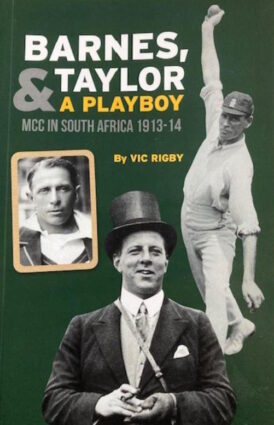Barnes, Taylor & A Playboy
Martin Chandler |Published: 2024
Pages: 193
Author: Rigby, Vic
Publisher: JW McKenzie Ltd
Rating: 4 stars

I do sometimes wonder if the disappearance of the traditional tour has played a part in the recent increase in the number of retrospective tour accounts being published. Only a couple of weeks ago I had the pleasure of reading a first ever account of South Africa’s tour of Australia in 1910/11, and in the coming weeks we will have the opportunity to relive two Ashes series one, for some of us, in living memory and the other not (1974/75 and 1926).
One such book I didn’t know about until it dropped through my letter box a couple of weeks ago is this one, a first ever account of the last tour of the Golden Age, England’s trip to South Africa in 1913/14. It is the tour that saw the Englishmen avenge their defeats at the hands of the South Africans on their two previous visits, and the great bowler Sydney Barnes take, despite missing the final Test, 49 wickets at 10.93, a series haul that remains a record to this day and is likely to be so in perpetuity given the way the game is now played.
There have been several biographies of Barnes and books aplenty by or about Jack Hobbs, who was in prime form for England throughout the tour. Of the England players the careers of Frank Woolley, Wilfred Rhodes, Johnny Douglas, Bert Strudwick, Tiger Smith, Phil Mead, Major Booth and Lionel Tennyson (the Playboy of the book’s title) have all been chronicled so the series does not lack coverage, but there has been no previous attempt to write an account of the tour as a whole.
And it is an interesting story. Mindful of the two previous defeats the selectors chose a strong side, although the South Africans were only prepared to finance a party of 13. On the other hand the nucleus of the successful South African sides of 1905/06 and 1909/10 was gone, although a top class batsman, Herby Taylor, came to the fore during a series that is in many ways defined by the battle waged throughout the tour between Taylor and Barnes.
The tour was certainly not one that lacked incident, including a diplomatic one in the Orange Free State which almost saw the tourists being denied entry to their hotel. Before that a road accident threatened to end the tour as a car in which Hobbs, Booth and Strudwick were travelling turned turtle. Despite initial reports to the contrary only Booth had to miss much cricket as a result of the injuries sustained in what must have been a terrifying incident for all involved.
And then there was Tennyson. The future Lord’s performances on the field, he averaged 16.57 in the five Tests and 20.75 overall, were underwhelming but he had an eventful tour otherwise. Tennyson is largely forgotten today but is one of the most remarkable personalities to have played international cricket and whilst he did not need a lengthy introduction Rigby devotes a full chapter to introducing the man who despite his cricketing shortcomings on the trip certainly merits the mention he gets in the book’s title.
But top billing deservedly goes to the battle between Barnes and Taylor both in the Tests and the match between the tourists and Natal which, thanks to Taylor’s 91 and 100 and his monopolising the strike against Barnes, led to the tourists’ only defeat of the tour. There is also, thanks to correspondence that passed between publisher John McKenzie and both Taylor and Barnes, some new light cast on that aspect of the trip.
Another factor looked into in some depth is the reason for Barnes’ not playing in the fifth and final Test. At the time he was said to be unwell, but it was later revealed that Barnes declined to play because of a dispute over money. Then as now the game’s finances often stood centre stage, and no one ever got away with short changing Sydney Barnes.
There is a lot more to the 1913/14 tour than the last five Test matches played before the Great War, and that makes the task of writing an engrossing book about the series much easier than it might otherwise have been. That said any book about a cricket tour needs to have at its heart decent accounts of the Test matches played. The most compelling writing will always come from the pen of someone who actually saw the play, which of course is impossible here, but good writers with good source material can still produce a decent narrative, and Vic Rigby certainly does that.
Barnes, Taylor & A Playboy is recommended reading for anyone with an interest in the Golden Age. The book comes in two versions, a soft back version and a limited edition of 150 hardbacks. Both are available direct from the JW McKenzie.







Leave a comment